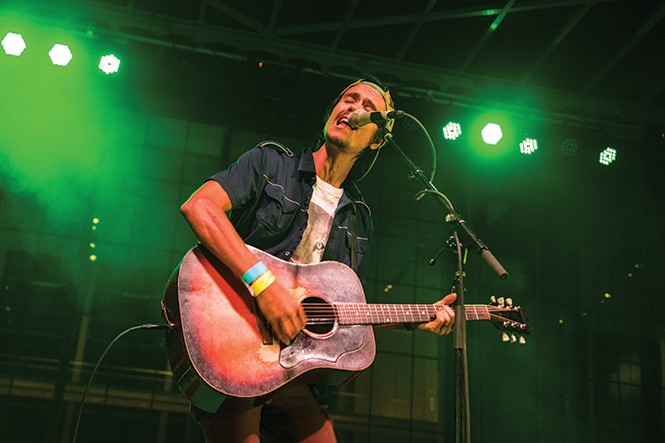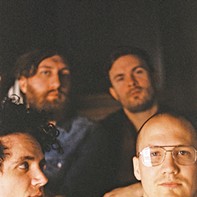I may be going about this all backwards. In Part 1 of this series I argued the Provo music scene has legitimate cultural and sociological importance—or at least intrigue—and that’s why Salt Lake City audiences should care about it. But maybe that puts the cart before the horse. I didn’t get interested in the scene for those reasons, after all. Like most people do, I got interested because of the music.
The significance of the music scene as some kind of cultural force probably matters far less if it was only producing variations on, say, “Mambo No. 5.” (No disrespect to Lou Bega, of course.) Whether or not the music is actually good plays a big part.
So, is the music good—as in, is it compelling, well-crafted, enjoyable, substantial? Much of it is, absolutely. The reasons why it’s good, and the reasons why it exists, are among the most interesting facets here.
An element of perceived novelty always seems to accompany coverage of the scene from outside parties (see: Rolling Stone’s 2014 feature on Neon Trees’ Tyler Glenn). Truthfully, the scene has blossomed precisely because of Provo’s idiosyncrasies.
Between Brigham Young University and Utah Valley University, Utah Valley has somewhere around 60,000 young adults. And that’s just the universities. What happens when you put 60,000-plus young adults, most of which come from religious backgrounds that value music, within a 60-square-mile area? And what if the non-student community within those 60 square miles is already fairly music-centric? And what if that area generally lacks a party culture and has relatively limited entertainment options? Of course those people are going to make music. Under the circumstances, it would be far stranger if they didn’t.
Of course, a scene needs more than people making music. It needs people performing and supporting it. For years, local venues like Velour Live Music Gallery, Muse Music Café and others have provided musicians with a stage, an audience and various kinds of support. The venues and those who run them have played an invaluable part in making the scene what it is today; it’s tough to picture what it would resemble without them. Like any vibrant arts scene, things can get competitive, sensitive and political at times, but the entry point is still decidedly lower than in larger markets where populations are bigger and touring acts play a more prominent role. Whether it’s a downtown venue or a house show, there’s always a place in Provo for musicians to blossom or whither.
Utah Valley’s hyperreligious mindset is critical, and in many ways it shapes both the quantity and quality of music coming out of here. Honestly, it seems like people don’t discuss or acknowledge this enough. I’m not totally sure why.
Whether religious or not, young adults are generally trying to find themselves. Take out the partying component of young self-discovery, though, and replace it with a spiritual, religious, hyperreflective one, and that sense of personal discovery becomes significantly more self-aware. I’d bet it also becomes far more purposeful and articulate. That’s not to imply the music scene is all just brooding, guilt-ridden Mormons, or that substances can’t facilitate great music. But the scene’s musicians all exist in a larger community that exercises intense self-reflection—and that kind of self-reflection is key to compelling artistic creation. Key to songs that are really about something meaningful.
Once again, given these circumstances, it would be strange if the scene weren’t producing good music.
OK, so the music exists, and it’s good, but that doesn’t completely explain why it’s been commercially successful.
A Provo musician told me something that shifted my perspective. Provo has become a nationally recognized hotbed for all kinds of entrepreneurialism. This musician told me you could classify Provo’s music scene as one sector of that fertile startup culture.
He’s absolutely right. The scene has become far savvier and focused about marketing and overall presentation than it used to be. Having local bands hit the Big Yime will do that. And these successful bands keep their ties to Provo, regularly playing here and supporting other local musicians. It makes local bands feel like national success is within their reach. (Perhaps more than it actually is—the scene is very band-oriented, and the mainstream music industry is way less so than it’s been in a long time.)
When outsiders perceive the Provo music scene as novel, their assessment isn’t totally wrong, it’s just incomplete. Taken collectively, the aforementioned factors that breed Provo’s music scene are somewhat novel. The fact that a scene exists within those factors is not.
These elements are all important because they indicate the music scene is far more reflective than reactive. People tend to view music scenes as counterculture, but most of Provo’s music scene is born from the same elements that make the rest of Provo tick.
Of course, portions of the scene don’t reflect Utah Valley’s mainstream values. Just because a local band plays for thousands at the Rooftop Concert Series doesn’t mean they represent the entire scene. Maybe the Provo community is embracing the tip of the musical iceberg and not the rest that exists under the surface. But they’re embracing a chunk of it, and that’s a start.
I imagine it’s becoming harder for the scene to collectively view itself as different/separate when it’s been embraced the way it has the past couple years. This embrace has happened simultaneously with the scene’s recent drought in major label attention—at least a drought compared to what was happening before. Basically, the scene’s defining characteristics—its separateness from Provo culture and its ongoing national success—existed on different ends of the social spectrum, and those characteristics don’t quite resemble their former selves. The scene’s new identity resides elsewhere.
That’s not a bad thing. Quite the opposite. Circumstances naturally change. And to create a new, more current identity for oneself is a precious opportunity.
The scene, and what’s happening within it, is a reflection of what’s happening throughout most of Provo. The city and region is growing and changing. It’s diversifying. Provo is becoming a more multifaceted force within the state, the region and the nation. That’s something Provo musicians should want to be a part of. And all that is probably worth some degree of your attention, even if you don’t live in Provo. As mentioned in Part 1, it’s a relatable, somewhat definitive theme for Utahns. The scene’s music is an interesting medium through which to view, or hear, this theme play out.
The best part, I think, is that so much remains unpredictable. Maybe a bunch of new Provo musicians will become nationally known within the next two years; there are plenty who seemed primed for it. Or maybe they won’t. Regardless, I think the scene’s self-concept will change, and I’m curious to see just how. The last two years have been far different than most had forecast; why would the next two be so predictable?
For Utahns, the larger societal factors that influence the Provo music scene (religion, youth, business, etc.) might be in plain sight. But as time has proven, its future is anyone’s guess. CW
Court Mann is a features reporter for the Daily Herald in Provo. Follow him on Twitter at @TheCourtMann.
More by Court Mann
-
Provo Music Primer
What everybody should know about Provo's musical ecosystem
- Jul 22, 2015
- More »
Latest in Music
Readers also liked…
-
The Alpines Head North
Local band's debut concept album finds musical bliss in the apocalypse.
- Feb 7, 2024




